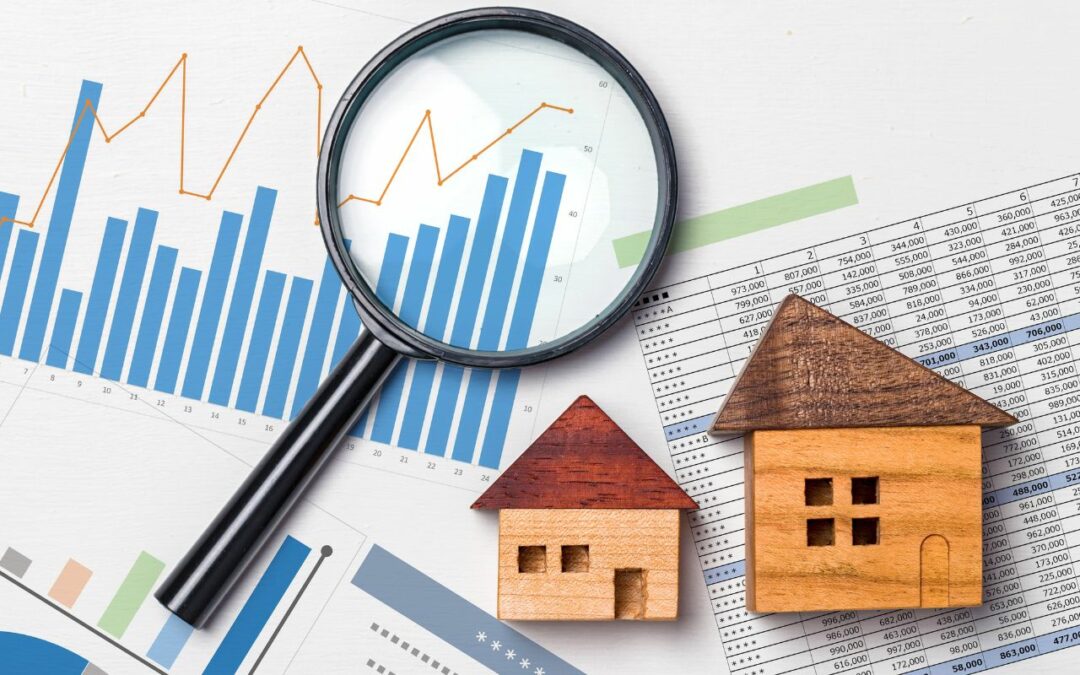As you dip your toes into the vast ocean of property markets, remember that every wave tells a story. Understanding these narratives can be the key to unlocking the potential of your investments.
By unraveling market trends, identifying crucial indicators, and dissecting the intricate dance between supply and demand, you pave the way for informed decisions.
But there’s more to this puzzle; a tapestry woven with economic threads, neighborhood hues, and competitive edges awaits your exploration.
Stay tuned to discover how these threads intertwine to create a comprehensive picture of property market analysis.
Key Takeaways
- Understand market trends through segmentation and rental yields.
- Identify key market indicators for demand and competitiveness.
- Analyze supply and demand dynamics for pricing trends.
- Evaluate economic factors and neighborhood development for investment insights.
Understanding Market Trends
To grasp the dynamics of property markets effectively, one must closely analyze and interpret the ever-evolving trends that shape buying and selling behaviors. Price fluctuations play a pivotal role in determining the attractiveness of real estate investments. Understanding these fluctuations can provide insights into the overall health of the market and help in making informed decisions. Market segmentation is another crucial aspect to consider. By dividing the market into distinct segments based on factors such as location, property type, and target demographic, investors can tailor their strategies to meet the specific needs of each segment.
Rental yields are essential metrics for investors looking to generate income through property investments. Calculating rental yields allows investors to assess the profitability of a property by comparing the rental income to the property’s value. This analysis helps in identifying properties that offer the best returns on investment.
Moreover, housing affordability is a key factor that influences buying and selling behaviors in the property market. Monitoring trends in housing affordability can provide valuable insights into the purchasing power of potential buyers and the overall demand for housing in a particular market. By staying abreast of these trends, investors can position themselves strategically to capitalize on emerging opportunities and mitigate risks.
Identifying Key Market Indicators
Identifying key market indicators is instrumental in gauging the pulse of property markets and making informed investment decisions based on solid data analysis. To navigate the complexities of the real estate world effectively, consider the following essential factors:
- Market Segmentation Analysis: Understanding the different segments within the property market can provide valuable insights into where the demand is strongest, helping you tailor your investment strategy to meet specific market needs.
- Competitor Benchmarking: Keeping an eye on your competitors allows you to assess how your properties stack up against others in the market. This analysis can uncover areas where you excel and where there’s room for improvement, guiding your future investment decisions.
- Consumer Sentiment Analysis: Monitoring consumer sentiment towards property markets can offer critical insights into trends, preferences, and potential shifts in demand. By understanding what drives consumer behavior, you can adapt your strategies to meet evolving market demands effectively.
Researching Local Market Data
Understanding the nuances of local market data is pivotal for gaining a comprehensive view of property dynamics and informing strategic investment decisions. When researching local market data, one crucial aspect to consider is comparative pricing. Analyzing how properties in the area are priced in relation to each other can provide valuable insights into market trends and potential investment opportunities. By comparing similar properties in terms of size, location, and features, you can better understand the competitive landscape and determine the potential value of a property.
Another essential factor to explore is local demographics. Understanding the demographics of an area, such as population trends, income levels, and age distribution, can help you assess the demand for different types of properties. For example, if an area has a growing population of young professionals, there may be a higher demand for rental properties close to urban centers. By delving into local demographic data, you can align your investment strategy with the needs and preferences of the community, increasing the likelihood of a successful investment.
Analyzing Supply and Demand Dynamics
How do market dynamics of supply and demand influence property values and investment opportunities in a given area? Understanding the interplay between supply and demand is crucial for making informed investment decisions in real estate. Here are some key points to consider:
- Demand Spikes, Supply Dips: When demand for properties in a particular area suddenly rises, it can lead to a spike in property values. This heightened demand may be driven by factors such as job growth, low-interest rates, or attractive amenities in the neighborhood. On the flip side, if the supply of available properties decreases, perhaps due to limited land availability or strict zoning regulations, it can further drive up prices.
- Market Equilibrium Fluctuations: Real estate markets are constantly in flux as they strive to reach equilibrium between supply and demand. Understanding these fluctuations is essential for predicting future trends. For instance, if there’s an oversupply of properties in an area, prices may decrease as sellers compete for buyers. Conversely, a shortage of available properties can lead to bidding wars and inflated prices.
- Data-Driven Decision Making: To effectively analyze supply and demand dynamics, rely on data such as sales figures, rental rates, and inventory levels. By tracking these metrics over time, you can identify patterns and make more informed investment choices.
Evaluating Economic Factors
Economic factors play a pivotal role in shaping the landscape of property markets, influencing investment decisions and property values significantly. Understanding economic forecasts and market cycles is crucial for making informed decisions in real estate. By analyzing economic indicators such as GDP growth, employment rates, and interest rates, you can gain valuable insights into the direction that property markets may take.
Demographic shifts also play a key role in determining investment opportunities within property markets. Changes in population size, age distribution, and income levels can all impact the demand for different types of properties. For instance, an area experiencing an influx of young professionals may present opportunities for investing in rental properties, while regions with an aging population might see increased demand for retirement communities.
Keeping a close eye on economic forecasts and demographic trends can help you identify emerging opportunities and potential risks in property markets. By aligning your investment strategies with these factors, you can position yourself to capitalize on market cycles and make well-informed decisions that drive success in real estate ventures.
Assessing Neighborhood Development
When analyzing property markets, it’s crucial to assess neighborhood development trends and the impact of amenities. Understanding growth patterns in neighborhoods can provide valuable insights into future property values and investment opportunities.
Growth Trends in Neighborhoods
Examining the evolving patterns of growth and development in neighborhoods provides valuable insights into property market dynamics. Understanding neighborhood demographics and property appreciation trends is crucial for making informed investment decisions.
Here are three key points to consider:
- Population Changes: Analyze how the neighborhood’s population has been shifting over the past few years. Increasing population can indicate a thriving area with potential for property value growth.
- Infrastructure Development: Keep an eye on any new infrastructure projects or developments in the neighborhood. Improved infrastructure often leads to increased property demand and higher appreciation rates.
- Commercial Growth: Monitor the growth of commercial establishments in the area. A rise in businesses can attract more residents, positively impacting property values.
Impact of Amenities
Analyzing the impact of amenities in a neighborhood is crucial for assessing its development trajectory and potential property market performance. The accessibility to amenities such as parks, schools, shopping centers, and public transportation can significantly influence property values and demand.
Neighborhoods with well-maintained amenities often attract more residents and businesses, leading to increased property market activity and potential value appreciation. Data on the availability and quality of amenities within a neighborhood can provide valuable insights into its overall desirability and long-term sustainability.
Understanding how amenities impact a neighborhood allows property market analysts to make informed predictions about future growth trends and investment opportunities. By considering the impact of amenities, investors can better evaluate the potential returns and risks associated with properties in different neighborhoods.
Monitoring Competition in the Market
To effectively gauge the competitive landscape in property markets, it’s imperative to delve into the intricacies of market dynamics and assess the strategies employed by key players. Competitor analysis is crucial to understanding the strengths and weaknesses of other businesses in the market. Here are some key points to consider:
- Identify Key Competitors: Begin by identifying major players in the property market. Understanding who your competitors are is essential for devising effective strategies.
- Analyze Market Saturation: Evaluate the level of market saturation in your target area. Assessing how many competitors are operating in a specific location can help you determine the level of competition you’ll face.
- Study Competitor Strategies: Analyze the tactics and strategies employed by your competitors. This analysis can provide valuable insights into what works well in the market and help you differentiate your offerings.
Utilizing Real Estate Market Tools
You can enhance your market analysis by leveraging advanced tools that offer comprehensive data visualization options.
These tools enable you to track trends effectively and make informed decisions based on real-time market insights.
Market Analysis Tools
When evaluating property markets, using real estate market tools is essential for precision and accuracy in market analysis. Utilize the following tools for insightful analysis:
- Comparative Market Analysis (CMA): Conduct in-depth comparisons of similar properties to determine market value.
- Market Surveys: Gather data through surveys to understand consumer preferences and market trends.
- Data Analytics Platforms: Utilize advanced software to analyze large datasets for market insights.
These tools, including data visualization techniques and market research methods, provide the necessary framework for informed decision-making in the dynamic property market landscape. By incorporating these tools into your analysis, you can gain a comprehensive understanding of market conditions and make well-informed investment choices.
Data Visualization Options
Data visualization options play a crucial role in leveraging real estate market tools for comprehensive analysis and strategic decision-making. By employing various data visualization techniques, you can transform complex market analysis into easily digestible insights.
Infographic design is particularly useful in presenting property market trends in a visually appealing and informative manner. These visual representations allow you to quickly identify patterns, correlations, and outliers within the data, aiding in the formulation of well-informed decisions.
Whether it’s mapping out regional pricing variations or illustrating the fluctuation of rental yields over time, utilizing data visualization tools can enhance your understanding of the property market landscape. Make the most of these options to unlock valuable perspectives and stay ahead in your real estate endeavors.
Trend Monitoring Features
Utilize trend monitoring features within real estate market tools to track and analyze shifts in property market dynamics effectively. By leveraging data visualization techniques, you can uncover valuable insights and patterns that may guide your investment decisions.
Market analysis software offers a range of tools for trend tracking, allowing you to stay ahead of market fluctuations. Additionally, mastering data interpretation skills is crucial to extract meaningful conclusions from the vast amount of information available.
Incorporating these practices into your market analysis routine can provide you with a competitive edge and a deeper understanding of the property market landscape. Stay proactive in monitoring trends and interpreting data to make well-informed decisions in the dynamic real estate market.
Frequently Asked Questions
How Can I Determine if a Property Market Is Likely to Experience Future Growth or Decline Based on Current Trends?
To determine if a property market will grow or decline, analyze economic indicators and conduct thorough market research. Look for investment opportunities that align with trends and assess risks carefully.
What Impact Do Environmental Factors, Such as Climate Change or Natural Disasters, Have on Property Market Analysis?
In the realm of property market analysis, environmental factors like climate change and natural disasters wield significant influence. Climate resilience impacts property values, with areas vulnerable to extreme weather facing potential devaluation.
Conversely, disaster preparedness can mitigate risks and stabilize market fluctuations. By integrating data on environmental risks, analysts can provide insights that enhance decision-making and foster sustainable growth in property markets.
How Do Zoning Regulations and City Planning Initiatives Affect Property Market Dynamics?
When evaluating property markets, consider how zoning regulations and city planning initiatives impact dynamics. Land use regulations dictate what can be built where, influencing property values and market demand.
Urban development plans shape infrastructure, transportation, and amenities, affecting attractiveness and desirability. Understanding these factors is key to predicting market trends and investment opportunities.
What Role Do Demographic Shifts, Such as Population Growth or Aging Populations, Play in Property Market Trends?
Population growth directly impacts housing demand, influencing property market trends significantly. As cities experience an influx of residents, the need for housing increases, driving up prices and creating opportunities for real estate investors.
Conversely, areas with aging populations may see a shift in demand towards smaller homes or retirement communities. Understanding these demographic shifts is key to making informed decisions in the property market.
How Can I Assess the Potential Impact of Technological Advancements, Such as Smart Home Technology or Virtual Reality Tours, on Property Market Competitiveness?
When evaluating the impact of technological advancements like smart home features or virtual reality tours on property market competitiveness, consider how these innovations align with consumer preferences. Technology can enhance market appeal by offering convenience and customization.
Assess how these tools differentiate properties in a crowded market and drive innovation. Understanding the intersection of consumer desires and technological trends will be key to staying competitive in the evolving property market landscape.
Final Thoughts
Analyzing property markets is like navigating a complex maze of data and trends.
By understanding market indicators, researching local data, and evaluating economic factors, you can make informed decisions.
Keep an eye on neighborhood development, monitor competition, and utilize real estate tools to stay ahead.
With a strategic approach, you can unlock opportunities and maximize your investments in the ever-evolving market landscape.














